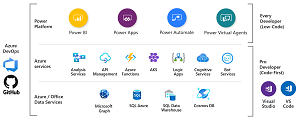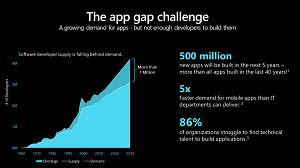News
Microsoft's Low-Code Power Apps Leans on Azure Cloud
The Azure cloud computing platform is dominating news coming out of the ongoing Microsoft Ignite 2020 developer/IT pro event, even extending to low-code application development with the company's Power Apps offering.
Power Apps, part of Microsoft's Power Platform, is the company's low-code offering, helping non-professional developers, commonly called "business users," quickly create enterprise applications. As with other low-code offerings, it leverages techniques such as pre-built templates and drag-and-drop composability to avoid having to write actual programming code.
 [Click on image for larger view.] The Power Platform, Azure DevOps and GitHub (source: Microsoft).
[Click on image for larger view.] The Power Platform, Azure DevOps and GitHub (source: Microsoft).
It's part of the rapidly expanding universe of do-it-yourself app development, with other techniques including wizards, model-driven schemes and so on.
The idea is to enable those ordinary business users to satiate the ever-growing demand for enterprise apps amid a dearth of hard-to-find -- and highly paid -- professional developers.
That enterprise app gap is exacerbated by the current coronavirus pandemic, as Microsoft illustrated this week with this graphic:
 [Click on image for larger view.] The Enterprise App Gap (source: Microsoft).
[Click on image for larger view.] The Enterprise App Gap (source: Microsoft).
"To respond to the growing demand for digital solutions, pro developers are increasingly looking for ways to blend code-first tools with low-code tools like Power Apps to accelerate their delivery of business apps," Microsoft said. "Low-code platforms help pro developers move faster, and without taking away the ability to use code when needed. Power Apps is the only low code platform that has been built from the ground up to work together with pro developer platforms like Azure, Visual Studio and GitHub. That means you can build solutions with low-code or code-first without stitching together different platforms."
At the start of Ignite 2020, Microsoft announced new capabilities for the Power Platform, with Azure featured prominently:
- Microsoft Power Apps and Microsoft Azure API Management now seamlessly work together to allow developers to scale Power Apps solutions with custom connectors hosted in Azure.
- Power Platform is integrated into GitHub, the place where developer teams collaborate on projects.
- Microsoft Power Virtual Agents and Microsoft Azure Bot Framework are now connected to allow developers and business users to build bots together.
- Microsoft Power Automate Desktop allows developers to automate desktop activities as part of their solutions using the new desktop client or through APIs.
In describing that first item about Azure API management -- which is coming in preview next month -- Microsoft said, "Developers may now leverage Azure Functions and Azure API Management to create custom APIs to unlock access to any Microsoft cloud hosted data source."
Furthermore, the company said developers can now quickly publish connectors backed by Azure API Management to the Power Platform for easier discovery and consumption.
That enables low-code developers to build apps that leverage those connectors via Power Apps hosted in Teams without incurring additional licensing costs.
Concerning the Azure Bot Framework, the company said, "Bot makers will now be able to use Azure development tools like Bot Framework Composer to create custom dialogs and directly add them to Power Virtual Agents bots. These dialogs can be saved, hosted, and executed together with Power Virtual Agents bot content, which provides a simpler way to extend bot capabilities with custom code and does not require additional Azure hosting, deployment, or billing complexities."
A preview for that feature is expected this fall, with no more specific timeline provided.
All of the above and more is detailed in the Sept. 22 blog post titled "Achieve your app development goals with Power Platform and Azure."
The company also published another blog post dealing more with the broader Power Platform and Dynamics 365 (CRM and ERP), announcing new capabilities such as:
- Power Platform SDLC (software development lifecycle) workflows and templates with GitHub Actions.
- Deeper Power Apps and Teams integration, including Power Apps authoring app within Teams, Project Oakdale for a free low code data platform, and Teams visual style support.
- The preview of the Microsoft Power BI app for Teams which provides a central, personalized home for data in Teams will help customers scale insights across the organization by ensuring that insights are just a click away from where conversations are happening and where decisions are made.
- Power BI is now natively integrated with Excel and is easier than ever to discover and work with trusted Power BI datasets that are refreshed, governed, and secured directly in Excel.
- Two new Power BI offerings: Power BI Premium Per User as an entry point to Premium and a new on-demand capacity scale option for Premium customers.
- The preview of Microsoft Power Automate Desktop, bringing robotic process automation (RPA) to every desktop.
- A new first-party voice channel for Microsoft Dynamics 365 Customer Service, built on Microsoft Azure Communication Services.
- New add-ins for Microsoft Dynamics 365 Supply Chain Management: Cloud and Edge Scale Unit and Inventory Visibility.
- The October general availability of Microsoft Dynamics 365 Project Operations.
Microsoft Ignite 2020 concluded Thursday, Sept. 24.
For more coverage of Microsoft Ignite 2020 from Virtualization & Cloud Review and sister sites, see:
About the Author
David Ramel is an editor and writer at Converge 360.